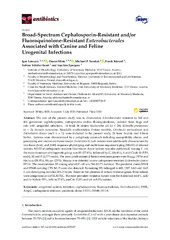Приказ основних података о документу
Broad-spectrum cephalosporin-resistant and/or fluoroquinolone-resistant enterobacterales associated with canine and feline urogenital infections
| dc.creator | Loncaric, Igor | |
| dc.creator | Mišić, Dušan | |
| dc.creator | Szostak, Michael P. | |
| dc.creator | Künzel, Frank | |
| dc.creator | Schäfer-Somi, Sabine | |
| dc.creator | Spergser, Joachim | |
| dc.date.accessioned | 2020-08-14T07:23:01Z | |
| dc.date.available | 2020-08-14T07:23:01Z | |
| dc.date.issued | 2020 | |
| dc.identifier.issn | 2079-6382 | |
| dc.identifier.uri | https://vet-erinar.vet.bg.ac.rs/handle/123456789/1853 | |
| dc.description.abstract | The aim of the present study was to characterize Enterobacterales resistant to 3rd and 4th generation cephalosporins, carbapenems and/or fluoroquinolones, isolated from dogs and cats with urogenital infections. In total, 36 strains (Escherichia coli (n = 28), Klebsiella pneumoniae (n = 3), Serratia marcescens, Raoultella ornithinolytica, Proteus mirabilis, Citrobacter portucalensis and Enterobacter cloacae (each n = 1)) were included in the present study, 28 from Austria and 8 from Serbia. Isolates were characterized by a polyphasic approach including susceptibility pheno-and genotyping and microarray-based assays. Escherichia (E.) coli isolates were additionally characterized by two-locus (fumC and fimH) sequence phylotyping and multi-locus sequence typing (MLST) of selected isolates. MLST of carbapenem-resistant Enterobacter cloacae isolates was also performed. Among E. coli, the most dominant phylogenetic group was B1 (27.8%), followed by C, (16.6%), A and Clade II (5.5% each), B2 and F (2.77% each). The most predominant β-lactam resistance genes were blaTEM (70%) and blaCTX-M (38.8%), blaCMY (25%). blaNDM was detected in one carbapenem-resistant Enterobacter cloacae ST114. The most common ST among selected E. coli was 744 (10.7% isolates). The pandemic clones ST131 and ST648 carrying CTX-M-15 were also detected. Remaining STs belonged to 469, 1287, 1463 and 1642. E. coli clonotyping revealed 20 CH types. Based on the presence of certain virulence genes, three isolates were categorized as ExPEC/UPEC. The most prevalent virulence factors were fimH detected in 61%, iucD and iss both in 55%, iroN in 27.8%, papC in 13.8% and sat in 8.3% isolates. | en |
| dc.publisher | MDPI | |
| dc.rights | openAccess | |
| dc.rights.uri | https://creativecommons.org/licenses/by/4.0/ | |
| dc.source | Antibiotics | |
| dc.subject | AmpC | |
| dc.subject | Carbapenem-resistant | |
| dc.subject | Cephalosporins | |
| dc.subject | Enterobacterales | |
| dc.subject | ESBL | |
| dc.subject | Fluoroquinolones | |
| dc.subject | Infection | |
| dc.subject | Pandemic clone | |
| dc.subject | ST114 | |
| dc.subject | ST131 | |
| dc.subject | ST648 | |
| dc.subject | Urogenital system | |
| dc.title | Broad-spectrum cephalosporin-resistant and/or fluoroquinolone-resistant enterobacterales associated with canine and feline urogenital infections | en |
| dc.type | article | en |
| dc.rights.license | BY | |
| dcterms.abstract | Мишић, Душан; Лонцариц, Игор; Сцхäфер-Соми, Сабине; Спергсер, Јоацхим; Сзостак, Мицхаел П.; Кüнзел, Франк; | |
| dc.citation.volume | 9 | |
| dc.citation.issue | 7 | |
| dc.citation.spage | 387 | |
| dc.citation.rank | M21 | |
| dc.identifier.wos | 000554198800001 | |
| dc.identifier.doi | 10.3390/antibiotics9070387 | |
| dc.identifier.scopus | 2-s2.0-85087646952 | |
| dc.identifier.fulltext | https://vet-erinar.vet.bg.ac.rs/bitstream/id/4898/Broad-Spectrum_Cephalosporin-Resistant_and_pub_2020.pdf | |
| dc.type.version | publishedVersion |

